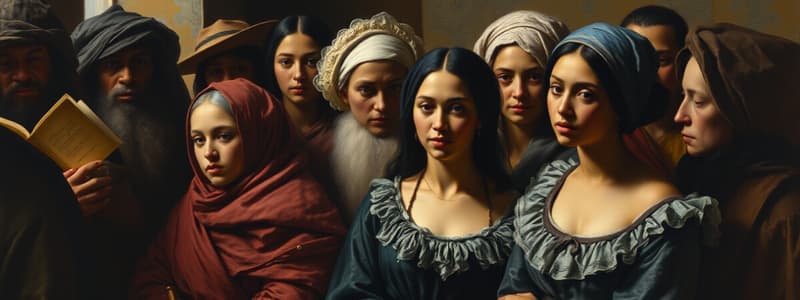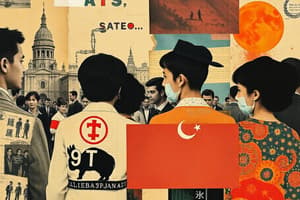Podcast
Questions and Answers
What is a minority group?
What is a minority group?
- Members of the group experience a pattern of advantage or equality.
- Members of the group tend to marry within the group. (correct)
- Members of the group are determined by their social status.
- Members of the group share a visible trait that differentiates them. (correct)
What is the most important characteristic of a minority group?
What is the most important characteristic of a minority group?
Inequality
What does stratification refer to?
What does stratification refer to?
The unequal distribution of valued goods and services.
How does being a member of a minority group affect access to property, prestige, and power?
How does being a member of a minority group affect access to property, prestige, and power?
What defines race?
What defines race?
What is ethnicity?
What is ethnicity?
Identify the characteristics of ethnic groups. (Select all that apply)
Identify the characteristics of ethnic groups. (Select all that apply)
What is racial formation?
What is racial formation?
Who argued that the most important source of inequality is economic production?
Who argued that the most important source of inequality is economic production?
What did Max Weber believe about stratification?
What did Max Weber believe about stratification?
What does intersectionality or intersection theory emphasize?
What does intersectionality or intersection theory emphasize?
What is prejudice?
What is prejudice?
What are stereotypes?
What are stereotypes?
What is discrimination?
What is discrimination?
What is ideological racism?
What is ideological racism?
What is institutional discrimination?
What is institutional discrimination?
What does modern racism mean?
What does modern racism mean?
What is white privilege?
What is white privilege?
What does assimilation mean?
What does assimilation mean?
What is the melting pot concept?
What is the melting pot concept?
What was established by the National Origins Act of 1924?
What was established by the National Origins Act of 1924?
What is symbolic ethnicity?
What is symbolic ethnicity?
Flashcards are hidden until you start studying
Study Notes
Minority Groups and Inequality
- Minority groups face patterns of disadvantage and inequality, clearly marked by visible traits.
- Membership in these groups is often determined at birth and includes a tendency for intra-group marriage.
- Inequality is the defining characteristic of minority status.
Stratification and Its Effects
- Stratification refers to the unequal distribution of valuable goods and services among groups.
- Membership in a minority group significantly impacts access to property, prestige, and power.
Understanding Race and Ethnicity
- Race categorizes individuals based on physical characteristics.
- Ethnicity distinguishes groups based on historical cultural practices and outlooks.
Characteristics of Ethnic Groups
- Unique cultural traits, community sense, ethnocentrism, ascribed membership from birth, and territoriality define ethnic groups.
Racial Formation and Theoretical Perspectives
- Racial formation is a social process of creating and transforming racial categories.
- Karl Marx emphasized economic production as the root cause of inequality, while Max Weber advocated a multidimensional view involving wealth, prestige, and power.
- Patricia Hill Collins highlighted the inadequacy of examining dimensions of inequality in isolation.
Intersectionality and Discrimination
- Intersectionality refers to the combined effects of race, class, and gender in creating multiple layers of inequality, creating a "matrix of domination."
- Prejudice represents negative attitudes towards entire groups, while stereotypes embody rigid beliefs about groups.
- Discrimination is the active exclusion from rights and opportunities based on group membership.
Racism and Its Forms
- Ideological racism justifies the inferior status of certain groups through cultural beliefs.
- Discrimination can occur at the individual or institutional level, with institutional discrimination embedded in societal operations.
- Modern racism is a subtle form of racism that avoids direct references to race while perpetuating inequality.
Social Change and Group Dynamics
- Assimilation involves merging distinct groups into a common culture.
- Pluralism allows groups to maintain their identities and cultural differences within society.
- Park's Race Relations Cycle illustrates phases of intergroup relations, starting with conflict and moving towards assimilation.
Key Social Concepts
- Primary groups are characterized by deep emotional ties and strong commitments, while secondary groups are larger and more impersonal.
- Human Capital Theory emphasizes individual characteristics like education in achieving success.
- Status Attainment Theory connects affluence and prestige primarily to education rather than family background.
Immigration Patterns and Cultural Dynamics
- Old Immigration refers to the first wave from Northern and Western Europe, while New Immigration refers to the later influx from Southern and Eastern Europe.
- Ethnic enclaves maintain cultural distinctions despite surrounding influences.
- The Principle of Third-Generation Interest suggests that the third generation of immigrants seeks to reconnect with traditions overlooked by the previous generation.
Structural Considerations and Historical Context
- The National Origins Act of 1924 established a quota system favoring Northern and Western Europe, reflecting systemic racism.
- The concept of symbolic ethnicity highlights the occasional salience of ethnic identity in everyday life.
Societal Structures and Ideologies
- Patriarchy denotes male dominance within families and public institutions.
- Cultural pluralism exists when groups retain identities without acculturation, while structural pluralism involves acculturation without full integration into society.
- Revolutions indicate efforts by minority groups to seek power parity with dominant groups, aiming to create new social order.
Studying That Suits You
Use AI to generate personalized quizzes and flashcards to suit your learning preferences.




